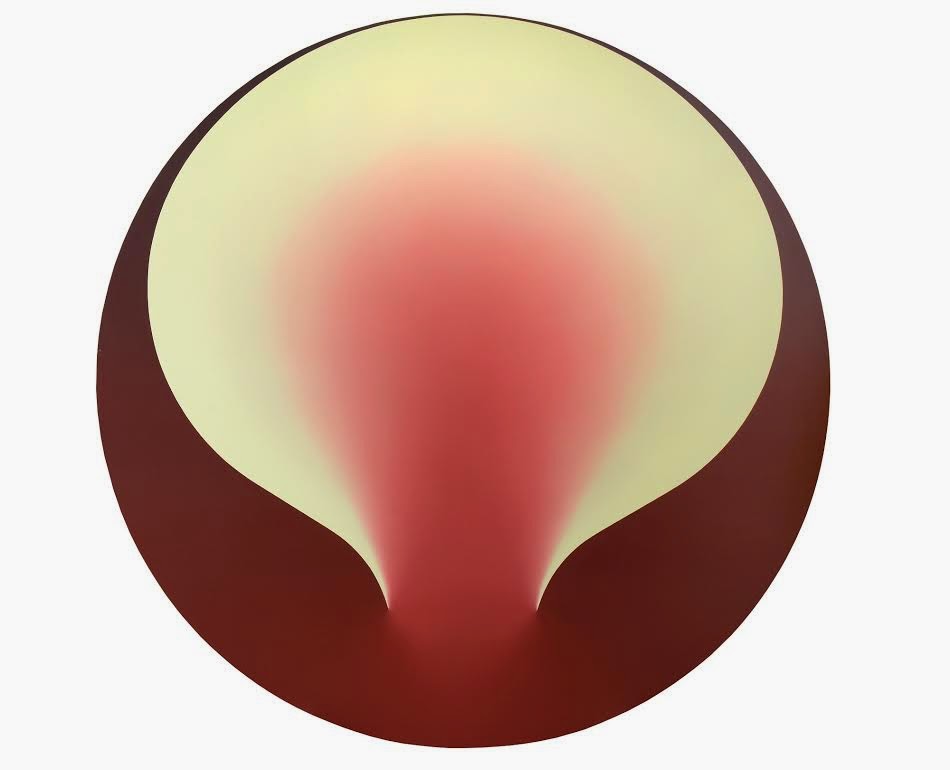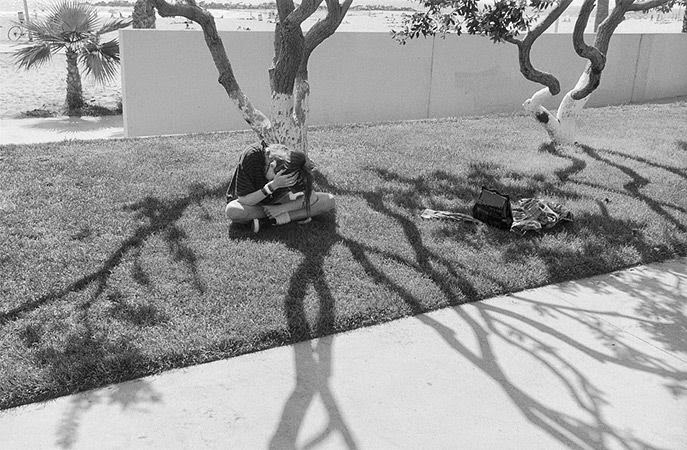The latest in my rolling top ten, together with previous choices which you can still see…
Taus Makhacheva: Vababai Vadadai! @ Narrative Projects, 110 New Cavendish St – Fitzrovia
One interesting space (New Narrative Projects) has become two (Christine Park at the original location and Narrative Projects in a new one). This second show at the new space takes us to the Caucasus, as the widely-shown Dagestan artist Taus Makhacheva brings a sharp insider’s eye to the enactment of masculine and feminine roles. A collection of vintage postcards sets up the stereotypes. A range of carved noses makes up the region’s characteristic mountain landscape. There are three films: male street posturing is recast as performative gesture; whereas a woman (the artist demonstrating her powers) unfussily clears a road of what looks like a massively heavy boulder; the post-Soviet inflation of marriage ceremonies with little authentic basis in tradition is mocked via the adoption of even more inflated dress. ‘Holy Moly!’ – or, as they say in Dagestan and in the show’s eponymous soundpiece, ‘Vababai Vadadai!’
 Still from A Space of Celebration, 2009
Still from A Space of Celebration, 2009 ____________________
Toby Christian: Some Sky @ Vigo Gallery, 21 Dering St – Central
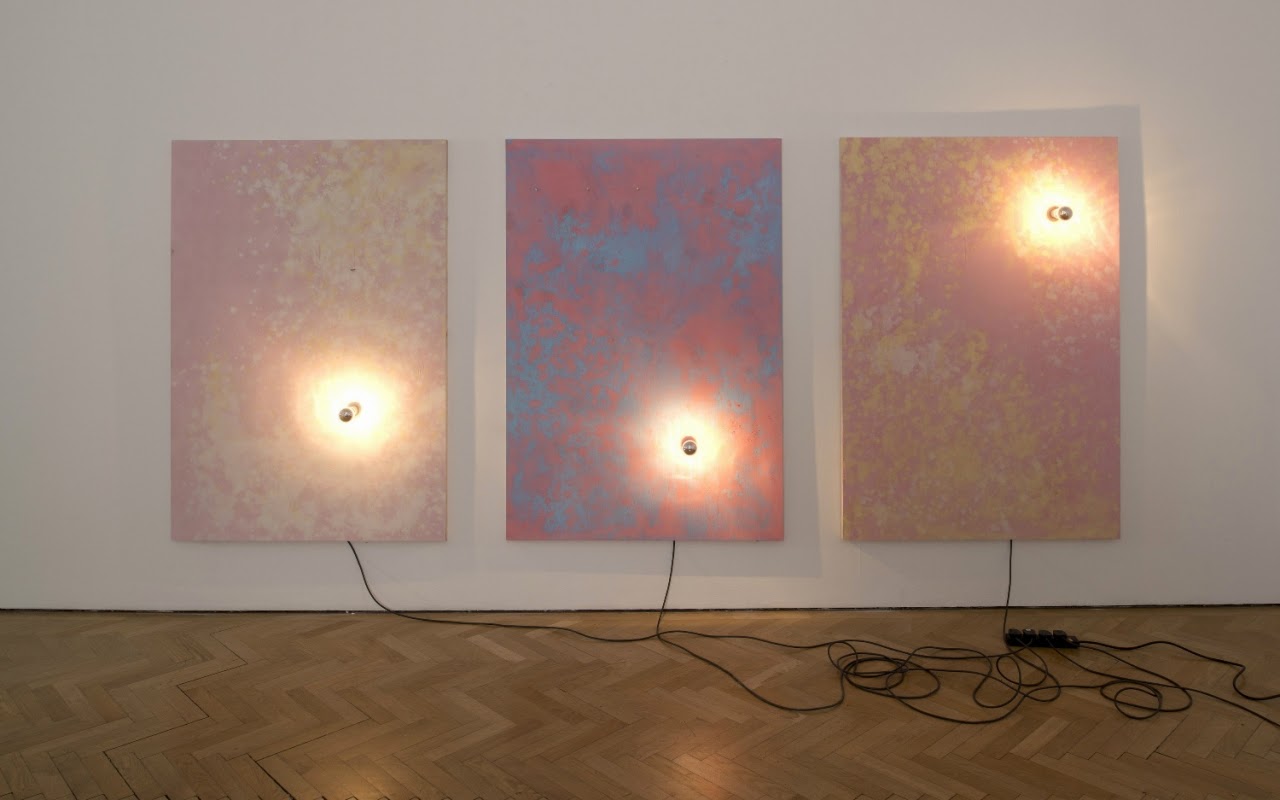 Installation view with ‘Sky Lights’
Installation view with ‘Sky Lights’ If you want your art elegant yet rough, simple yet reverberant – and why wouldn’t you? – look at the two main bodies of work here: one we might expect to tread on, one we might expect to lie beneath. Glasgow-based Toby Christian draws hesitantly evocative lines on tablets of concrete which read as the plans for rooms, but with aspects of their shapes proving more painterly than plausibly architectural. Then he introduces personalised real life by gouging the surface with his car keys. The much larger ‘Sky Lights’ mount a back-reflecting bulb on a surface of marbled paint, particles of chalk and the odd nail, all on beaten-up boards. That sets us ricocheting between on and off, lighter and lit, substance and shadow, sea and cloud, crucifixion and ascent, dream and reality…
%2B2015.jpg) Plan (Cover), 2015 – coloured pencil on scratched concrete, 29.7 x 21 cm
Plan (Cover), 2015 – coloured pencil on scratched concrete, 29.7 x 21 cm
____________________
Matt Stokes: Cantata Profana @ Dilston Grove, Southwark Park
 Cantata Profana
Cantata ProfanaThe refurbished concrete shell and adjacent parish hall of an ex-mission church prove ideal to show the most compelling of Matt Stokes’ investigations of sub-cultures. In Cantata Profana (2010) six extreme metal singers from such directly named bands as Norway’s She Said Destroy, USA’s Hatred Surge and Germany’s Paroxysm are given a screen each as they combine a capella in a dated GDR radio studio to sing a six minute composition by Orlando Gough, who exploits their extreme vocals to link them into modern choral styles. If you like beatboxing, grindcore or Ligeti – and surely most people go for one of that unlikely triad – you’ll be drawn in. Logically, you might link this with a visit to Stokes’ parallel show at Matt’s Gallery in Mile End, but his ponderous satire on the sit com form is hard to recommend; as is the less than user-friendly group show in Southwark Park’s nearby Café Gallery.
 Dilston Grove’s gallery entrance doors are a feature in themselves…
Dilston Grove’s gallery entrance doors are a feature in themselves… ____________________
George Rippon: Now Panic & Lena Henke and Marie Karlberg: One step away from further Hell @ Vilma Gold, 6 Minerva St – Cambridge HeathTo 25 April: www.vilmagold.com
 George Rippon: Forever Summerhouse, 2015 Limonium, lentils, coins, paper, photograph, allergy tablets, bottle caps, egg shell, chestnut, models, plaster 58.5 x 115 cm
George Rippon: Forever Summerhouse, 2015 Limonium, lentils, coins, paper, photograph, allergy tablets, bottle caps, egg shell, chestnut, models, plaster 58.5 x 115 cm
This pair of shows operate just out of the range of direct meaning, yet in a way I found fascinating rather than frustrating. Young Frankfurt-based American George Rippon’s sculptures and sculptural paintings make surprising use of the organic. They revel in such combinations as Allergy Allegory’s ‘dandelion, models, black rice, allergy tablets, epoxy, plaster’, which seems to embed a personal narrative-by-association of elements into its containing block. And New York based German and Swedish friends Lena Henke and Marie Karlberg, who’ve organised exhibitions together, present a two-hander in which it feels as if each artists’ work could be the other’s, though their backgrounds in sculpture and performance / fashion respectively are very different.
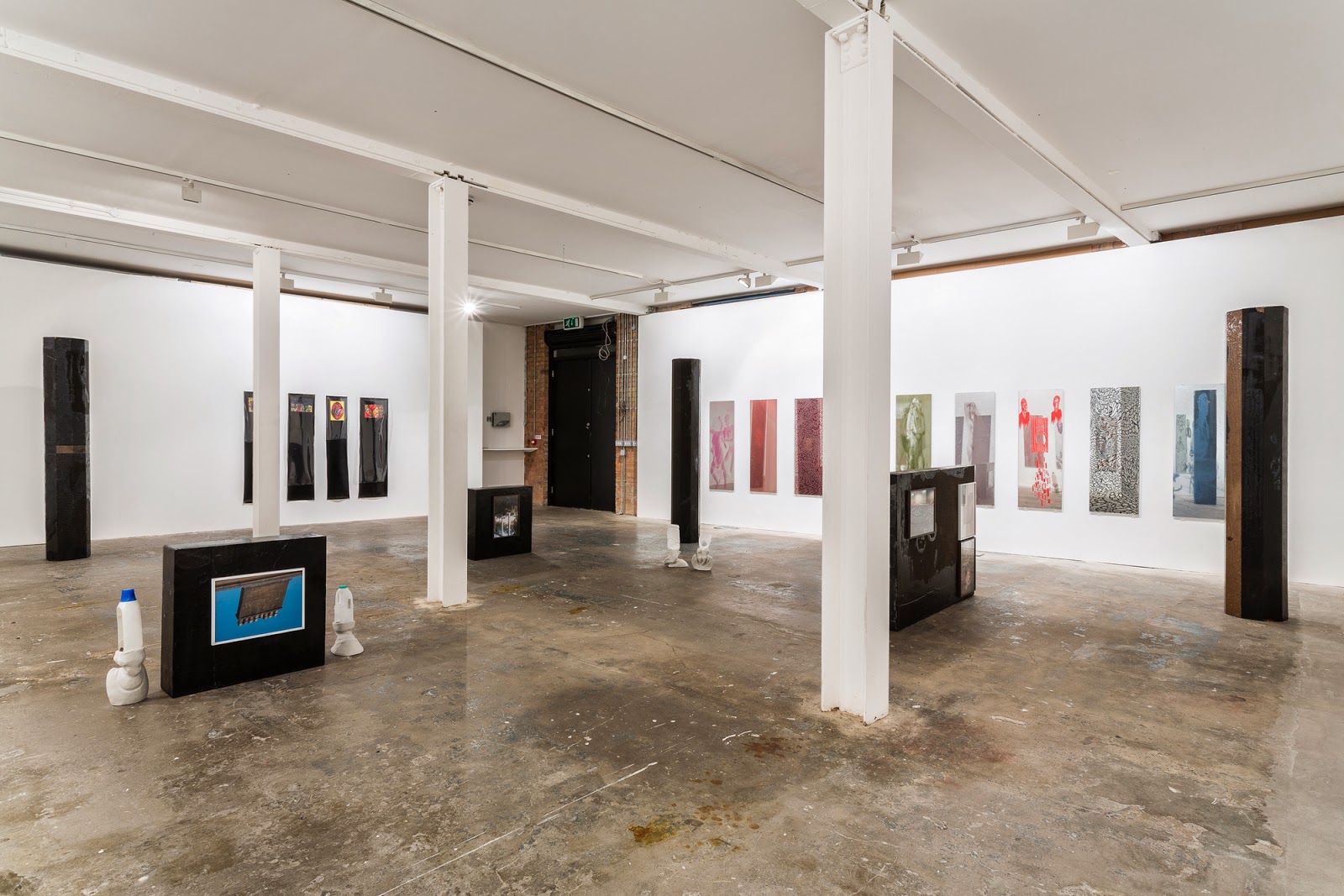 Lena Henke and Marie Karlberg: Installation view
Lena Henke and Marie Karlberg: Installation view
Roger Ackling: Simple Gifts @ Annely Juda Fine Art, 23 Dering Street – Central

Voewood (2013) – sunlight on wood with metal.15.4 x 6.5 x 15.6 cm
For 40 years before his death last year, Roger Ackling created small sculptures by directing sunlight through magnifying glass to burn images of the sun to make up parallel lines to track their forms dot by dot. Sort of small-scale Daniel Buren of more poetry than concept. These 80 pieces from Ackling’s last active year show lots of appealing variety of shape, size, contour effects, additional elements such as rings or an elastic band, and several variants pieces which enact a much freer line on the back of photo frames – as if to guess at an outline image the other side. If Ackling reduces the sun to an intimate scale, then it makes some sense that June Green, in the paired show, presents argangement of ‘pebble shapes’ big enough to count as serious rocks.

Voewood (2013) – sunlight on board with hinge support, 20.2 x 15.3 x 8.5 cm
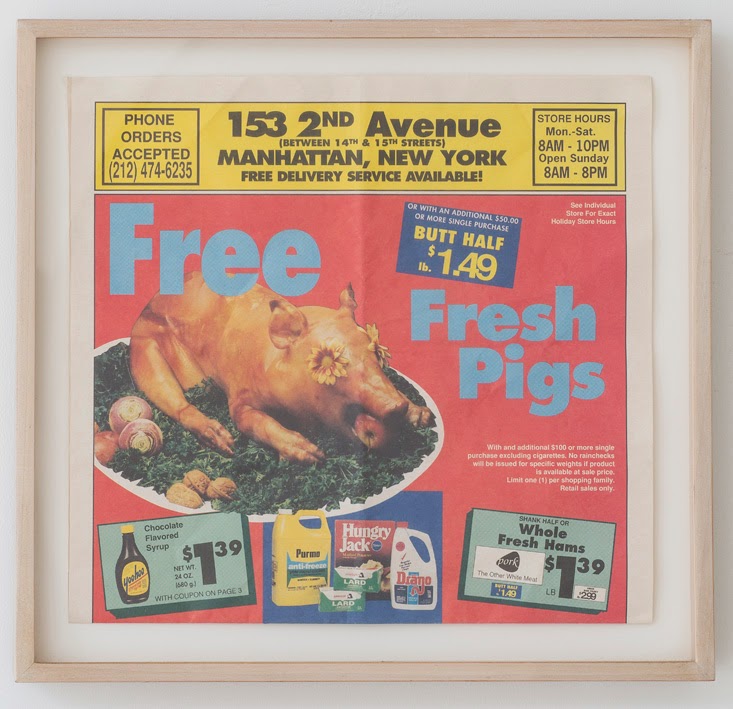
Robert Gober Untitled, 1993-94 photolithography on archival paper
What do you want in a group show? An interesting theme, links between works, some favourite artists and an interesting new one seem like a plausible requirements – which Ibid delivers. The easy familiarity of capitalist consumption at home is disrupted by a comedic trip in Francis Alys’ sensitive little encaustic, and the macabre aspect of roasting a whole pig in Robert Gober’s editions of newspaper adverts. That triggers our questioning of the apparent calm in Paul Theck’s painting on newspaper and leads thematically and onomastically to the new-to-me Romanian Razvan Boar, who – aside from his great name – abstracts from rote commercially sourced figuration by casually painterly blobs, scuffs and dirt somewhere in the space between Warhol and Oscar Murillo (David Spiller also comes to mind). Ross Chisholm provides two suitably weird portraits of parents to overlook the scene. All that’s missing is a porcine title – well, any title – for the show…

Razvan Boar Juice Tree, 2014 – oil, charcoal and spray paint on canvas
____________________
Ravilious @ Dulwich Picture Gallery, Gallery Rd – Dulwich
To 31 Aug: www.dulwichpicturegallery.org.uk
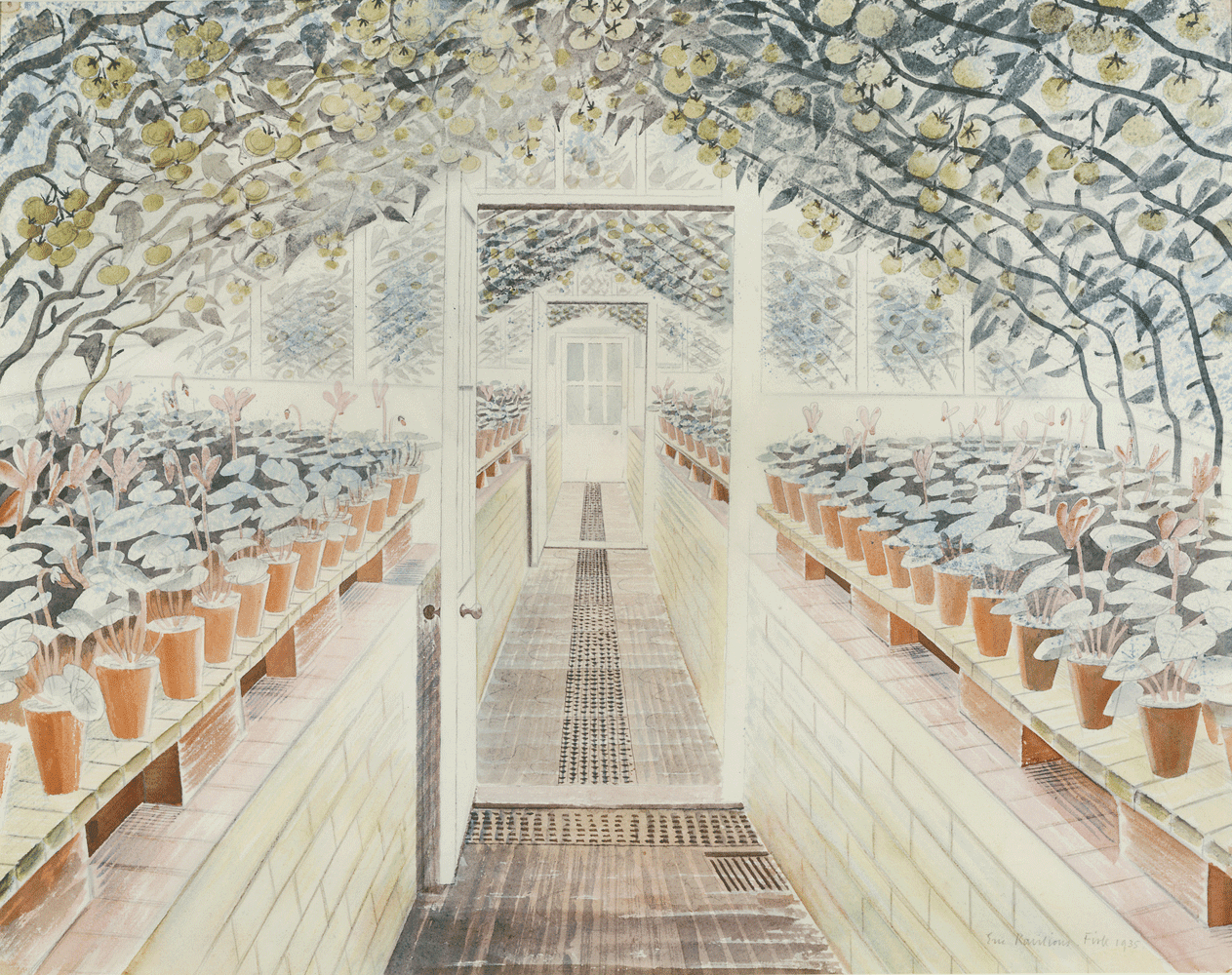 The Greenhouse, cyclamen and tomatoes, 1935
The Greenhouse, cyclamen and tomatoes, 1935
It isn’t hard to work out why Ravilious’s paintings appeal: his quirky eye for the objects and landscapes of the decade to his death in 1942 plays in to nostalgia tinged by the war to come or in progress; his apparently straightforward depictions are seeded with an almost vertiginous sense of underlying strangeness; he has a remarkable sense of how to build up a persuasive whole from detailed patterning of grass, sea, wallpaper or repeated flower pots, largely achieved by importing experience of making woodcuts into his watercolour production; and he has the most amazing watercolour technique, lighting clarity from within through the blazing white of the paper. Art history has taken little notice, but these 80-odd paintings are your best-ever chance to enjoy a ravishing achievement.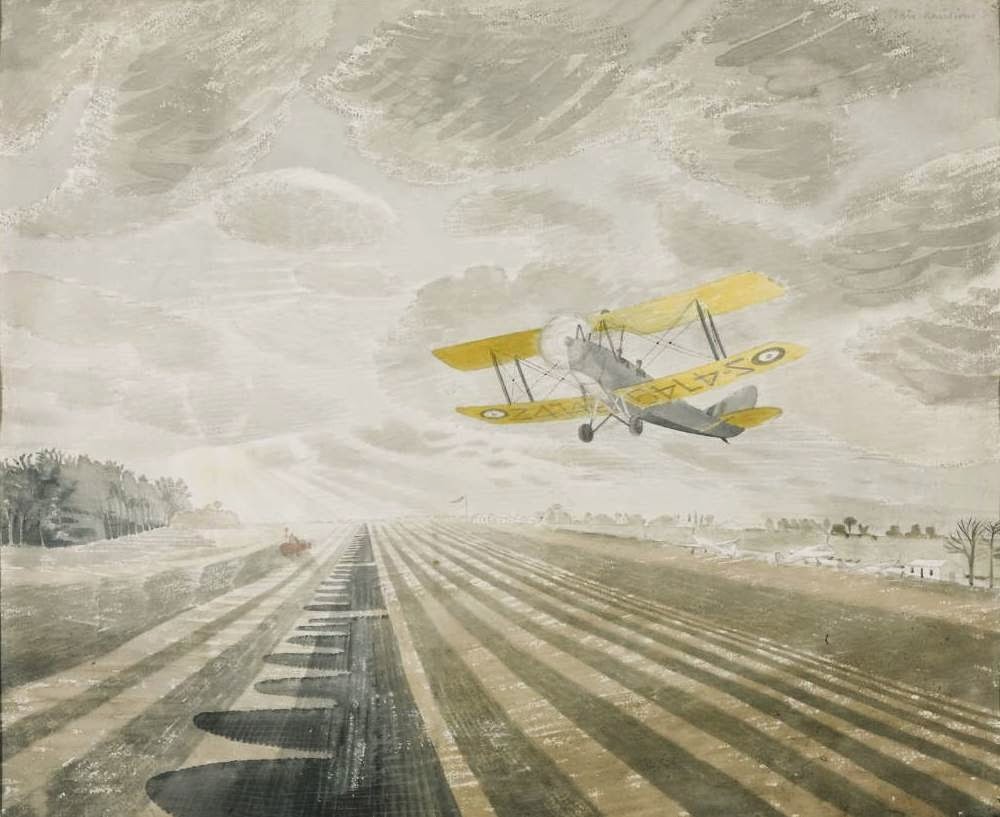
Tiger Moth, 1942
____________________ Ydessa Hendeles: From her wooden sleep… @ The ICA – Central
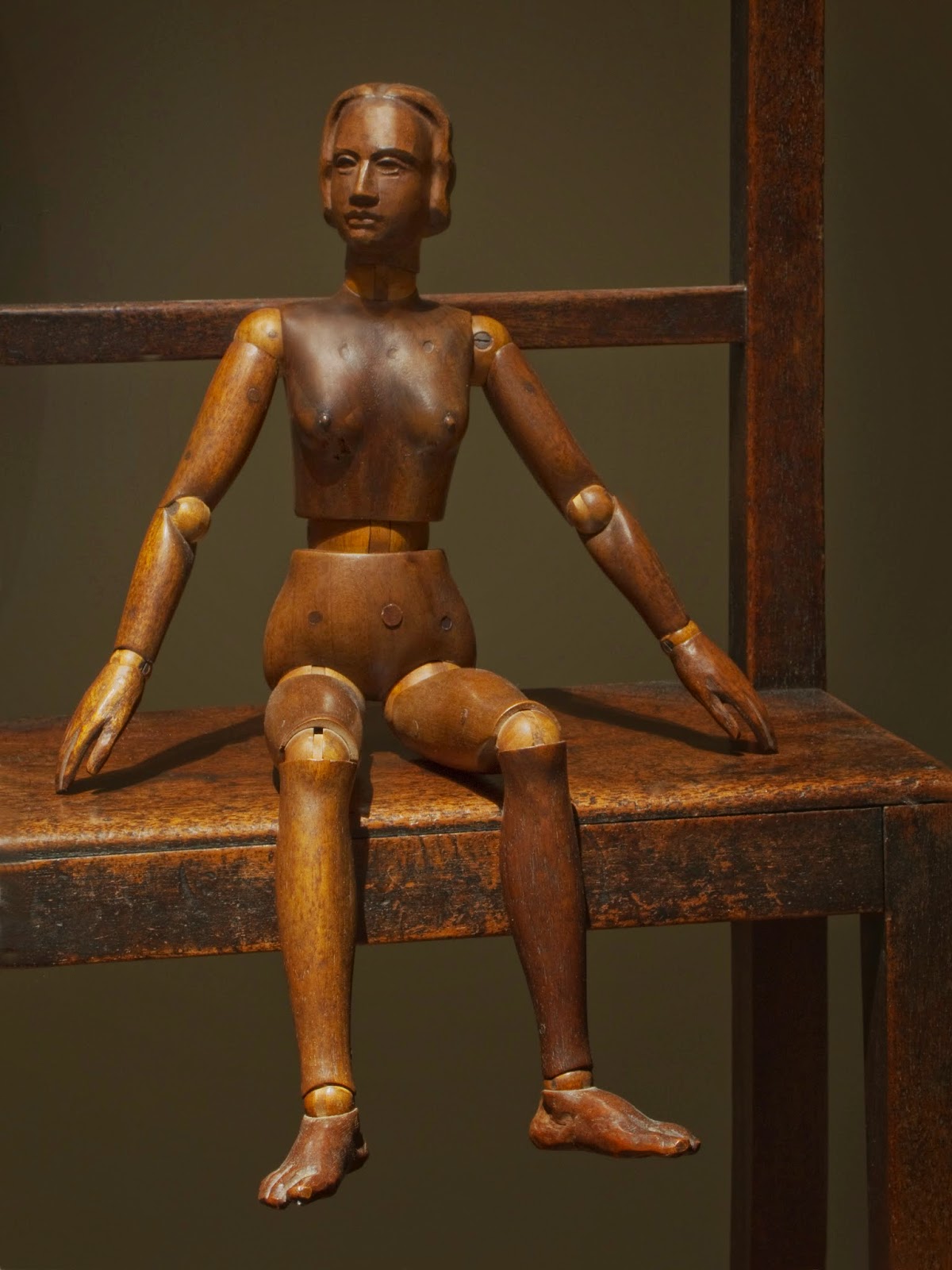
Ydessa Hendeles, From her wooden sleep…, 2013 (detail) photo by Robert Keziere
Draw a Venn diagram of two fascinating recent exhibitions – the Fitzwilliam’s history of the artist’s dummy, ‘Silent Partners’; and the Barbican’s ‘Magnificent Obsessions’ cornucopia of artists as collectors – and the intersection would contain this dramatic whole room tableau. Canadian Ydessa Helendes might best be described as a collector-curator who presents her finds with a precision which is art. Previous shows, mostly in her own Toronoto Foundation, have included a trove of 3000 photographs featuring teddy bears; here the central feature is some 180 very variously sized articulated artists’ manikins (used to supplement life models), complete with extensive seating, five mountain banjos and 18 fairground distortion mirrors contributing to an atmosphere made childishly menacing by Chopin’s ‘Golliwog’s Cakewalk’. On trend, for sure, but a trend which Helendes initiated…

Ydessa Hendeles, From her wooden sleep…, 2013 (detail) photo by Robert Keziere
______________________
Martin Wilner: Making History: The Case Histories 2014 @ Hales,Tea Building, 7 Bethnal Green Rd – Shoreditch
To 16 May : www.halesgallery.com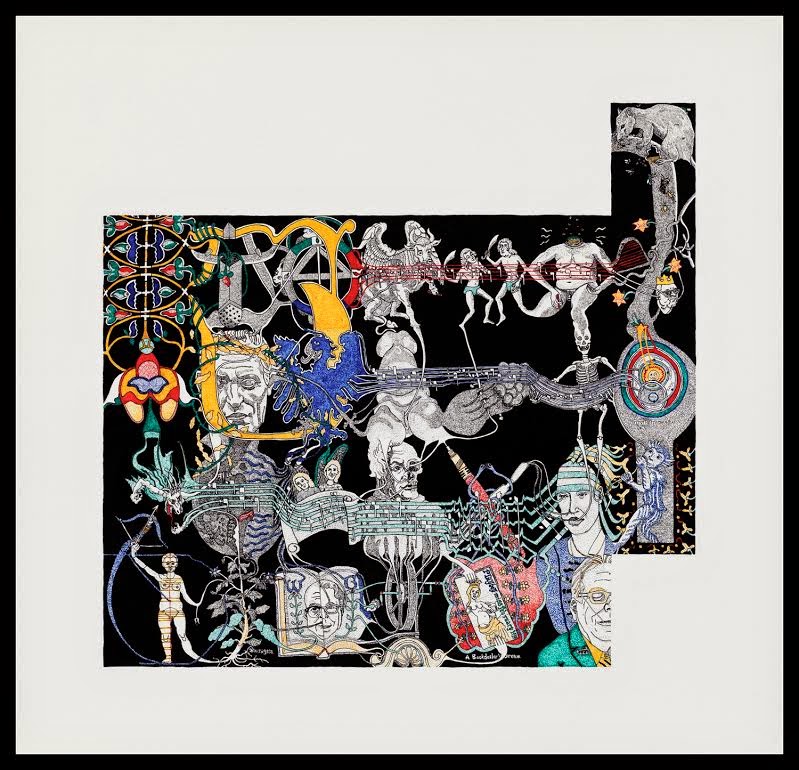
Five years ago Martin Wilner showed some of a fascinating and somewhat Opalka-like ten year project (2002-12) based on monthly accumulations of a daily drawing of what caught his eye in the newspapers. Now Wilner has embarked on a collaborative version, in which the items are taken from daily correspondence with a different person each month: Wilner transcribes the letter (often rather imaginatively) on one side of the paper, and draws what it triggers on the other. The results form calenders with Monday always top left so that slightly irregular shapes result – as months don’t tend to start on Monday and finish on Sunday. The new project not only forces Wilner out of a decade’s way of working, it also plays more directly into his USP: a half-time job as Associate Clinical Professor of Psychiatry at Cornell Medical College. The new work is more layered, and parallels his other professional practice of asking questions and interpreting answers to understand his subjects.
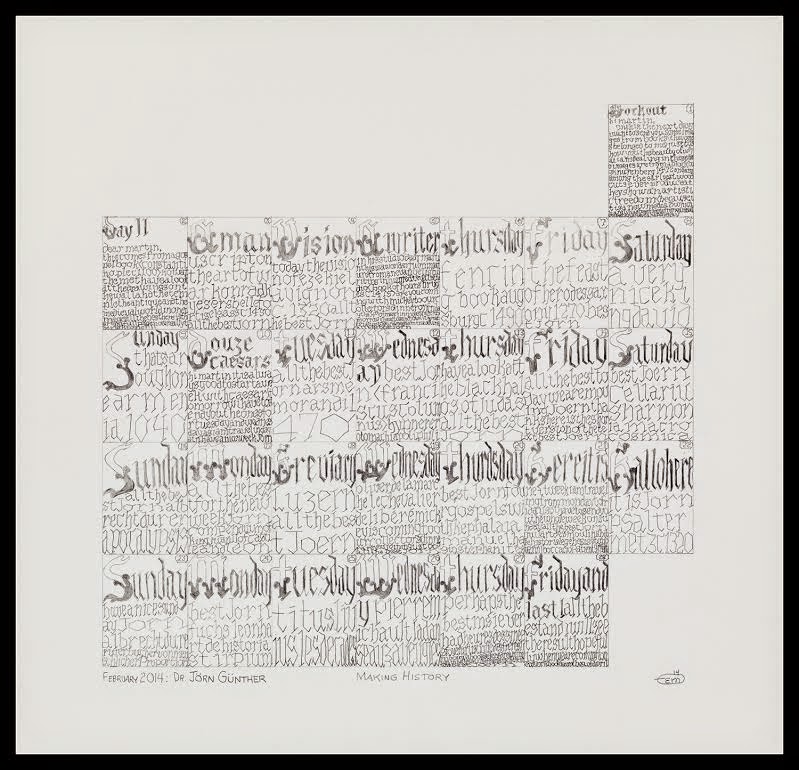
Images are Recto and Verso of Making History: Case Histories, February 2014: Dr Jorn Gunther, 2014 pen and ink on Bristol board, 41.9 x 43.5 cm copyright Martin Wilner, courtesy of Hales Gallery
______________________
Organic Sculpture @ Alison Jacques, 16-17 Berners St – Fitzrovia
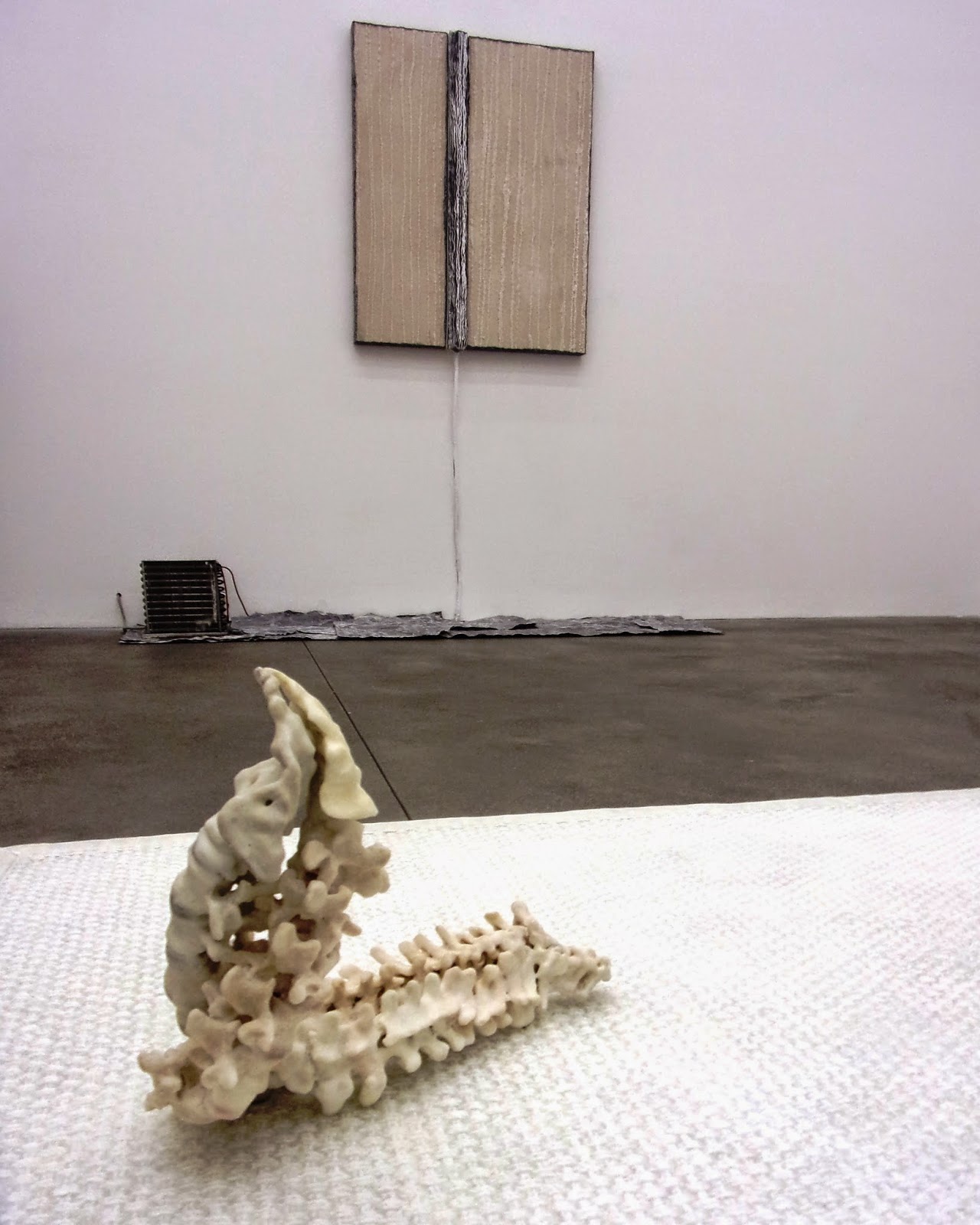
Installation view with Janine Antoni’s Polyurethane resin to twine, 2014 and behind it
Pier Paolo Calzolari Untitled, 1988 – Salt, lead, refrigeration unit, refrigerator motor
This isn’t sculpture made from organic materials, but 38 works by 15 artists, all of which arrives at broadly organic forms, resembling plants, eggs, bodies and their underlying geometries: the predominant media are ceramics and metals. It’s full of highlights, really, but hard not to mention Pier Paolo Calzolari’s refrigeration piece; Alina Szapocznikow’s polished bronze stones fitted cancerously into a tablet; the plaster works of the Slovak Maria Bartusova (1936-96), who only came to prominence in the last Documenta; and Janine Antoni’s twining of two cast spines in a transcendental connection which puts Marc Quin’s mating skeletons firmly in their place.
(See Top Photo)
At the opening, visitors Sissy (left) and Marta made quite a contrast with the aesthetics of Paolo Icaro’s white plaster Window Show, 1974 (and with the rest of the show come to that)
______________________
PREVIOUS CHOICES STILL ON
______________________
Santiago Taccetti: ISO 9001 @ Hus Gallery, 10 Hanover St & Nasan Tur @ Blain|Southern, 4 Hanover Square
 Santiago Taccetti: Untitled 15 (Einsatzbereich Innen – Außen), 2015 Household acrylic on canvas 200×145 cm – I think that would translate as ‘Application Indoor – Outdoor’
Santiago Taccetti: Untitled 15 (Einsatzbereich Innen – Außen), 2015 Household acrylic on canvas 200×145 cm – I think that would translate as ‘Application Indoor – Outdoor’
Two interesting shows from Berlin-based artists either side of Hanover Street show contrasting approaches to presenting conceptual work. At Hus (say ‘Hoos’) Argentinian Santiago Taccetti pursues two lines of enquiry into material properties: seven towers of aluminium ashtrays covered in speckly stone plaster become mysterious ash sculptures; and the cheapest possible household acrylic is spread roughly onto what proves to be the back of eight pre-primed white canvases. The point isn’t economy, but the chemical crudity of cheap paint, which makes it the best at crinkling the canvas into intricate patterns as it dries onto it. All that remains is to constrain that sculptural effect in a metal frame engraved with the chemical formula which controlled the unseen paint.
Compared with that, Blain Southern’s feels like a group show. Is that a Bill Viola slow motion human reaction film of people firing guns for the first time, a Walead Beshty pulping of what proves to be Das Kapital, a Martin Creed neon displaced to the floor, where it blazes a yellow CRISIS? And has that rather creepy collection of marble body fragments come from ancient statuary? But no, Turkish German artist Nasan Tur is adept at repurposing a wide variety of languages to his own ends, wittily pointing up the slippages between the political and personal and their conversion to art. A wall painting reproduces the results of police covering over graffiti; loss of bladder control is similarly presented as if it were a mere mark-making process; and what do we read into the post-discharge expressions of those gun virgins?
 Nathan Tur: Crisis, 2014
Nathan Tur: Crisis, 2014 ______________________
 Still from A Space of Celebration, 2009
Still from A Space of Celebration, 2009  Installation view with ‘Sky Lights’
Installation view with ‘Sky Lights’%2B2015.jpg) Plan (Cover), 2015 – coloured pencil on scratched concrete, 29.7 x 21 cm
Plan (Cover), 2015 – coloured pencil on scratched concrete, 29.7 x 21 cm George Rippon: Forever Summerhouse, 2015 Limonium, lentils, coins, paper, photograph, allergy tablets, bottle caps, egg shell, chestnut, models, plaster 58.5 x 115 cm
George Rippon: Forever Summerhouse, 2015 Limonium, lentils, coins, paper, photograph, allergy tablets, bottle caps, egg shell, chestnut, models, plaster 58.5 x 115 cm Lena Henke and Marie Karlberg: Installation view
Lena Henke and Marie Karlberg: Installation view

 The Greenhouse, cyclamen and tomatoes, 1935
The Greenhouse, cyclamen and tomatoes, 1935
 Santiago Taccetti: Untitled 15 (Einsatzbereich Innen – Außen), 2015 Household acrylic on canvas 200×145 cm – I think that would translate as ‘Application Indoor – Outdoor’
Santiago Taccetti: Untitled 15 (Einsatzbereich Innen – Außen), 2015 Household acrylic on canvas 200×145 cm – I think that would translate as ‘Application Indoor – Outdoor’ Nathan Tur: Crisis, 2014
Nathan Tur: Crisis, 2014 Untitled, 1971 – oil on canvas, 137 x 91 cm
Untitled, 1971 – oil on canvas, 137 x 91 cm Installation view: Jodie CareyEdel Assanti make the most of their new double space to pull off a resonant pair of shows which contrast sharply even as they tackle the common ground of prehistoric ritual and its recrudescence in modern society. Upstairs is all light and balance as Jodie Carey transforms disparate traditions of commemorative craft into a monumental installation of plaster vessels afloat on a sea of the pieces chipped off their blocky origins; woven canvas hangings dipped into plaster; and a delicately obsessive wall drawing. Down in the basement Russian artist Petr Davydtchenko provides a potted history of St Petersburg’s Hard Bass dance craze, executed in animal masks in most of his found footage, the growling sound system pumping out of sculptures into Stygian gloom.
Installation view: Jodie CareyEdel Assanti make the most of their new double space to pull off a resonant pair of shows which contrast sharply even as they tackle the common ground of prehistoric ritual and its recrudescence in modern society. Upstairs is all light and balance as Jodie Carey transforms disparate traditions of commemorative craft into a monumental installation of plaster vessels afloat on a sea of the pieces chipped off their blocky origins; woven canvas hangings dipped into plaster; and a delicately obsessive wall drawing. Down in the basement Russian artist Petr Davydtchenko provides a potted history of St Petersburg’s Hard Bass dance craze, executed in animal masks in most of his found footage, the growling sound system pumping out of sculptures into Stygian gloom. Installation view: Petr Davydtchenko
Installation view: Petr Davydtchenko









